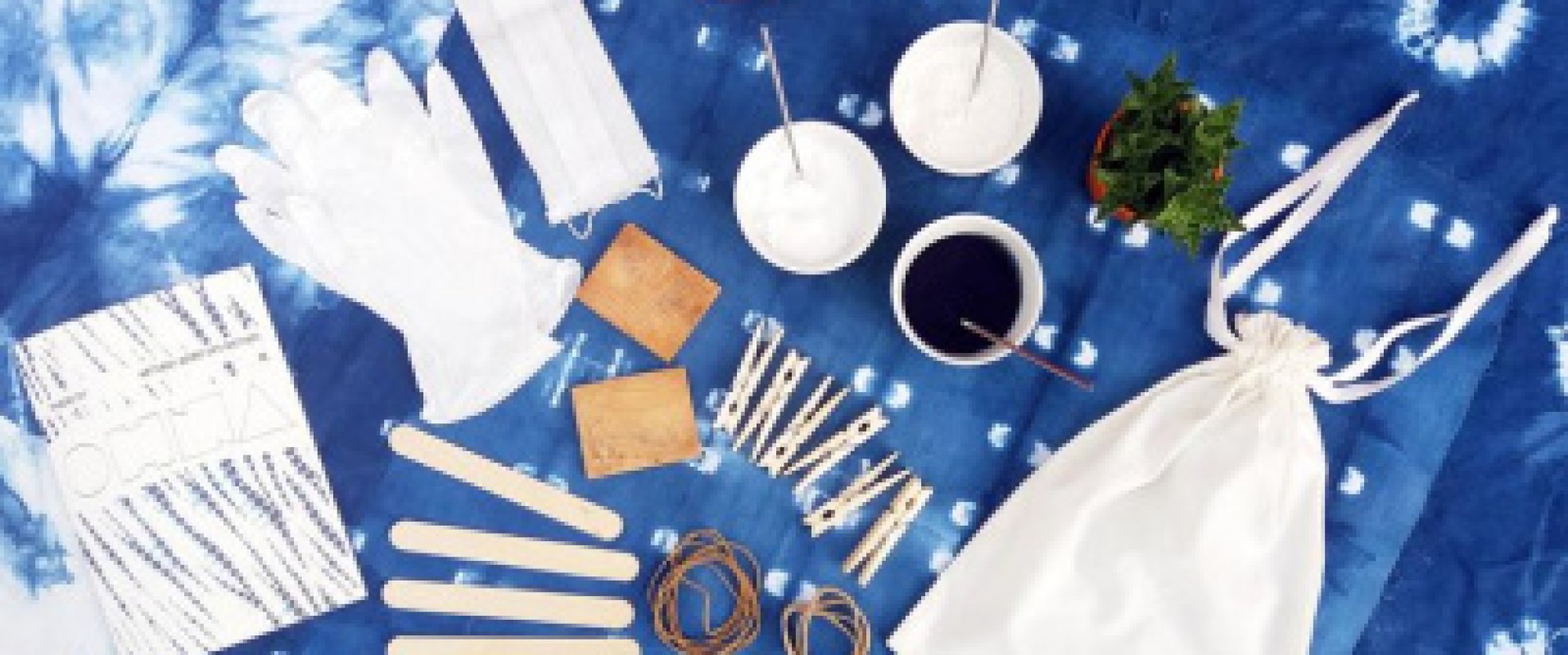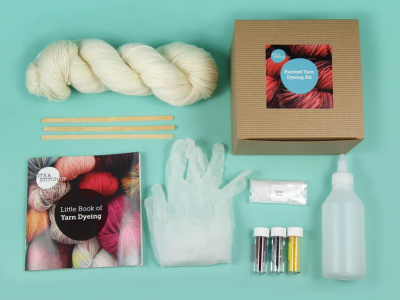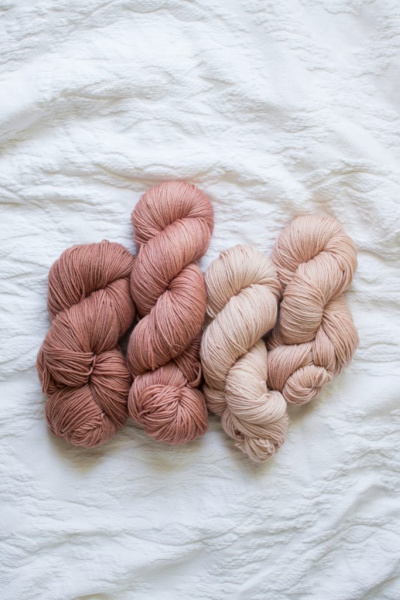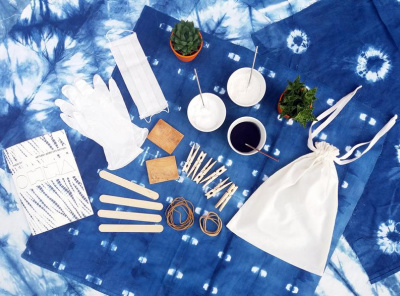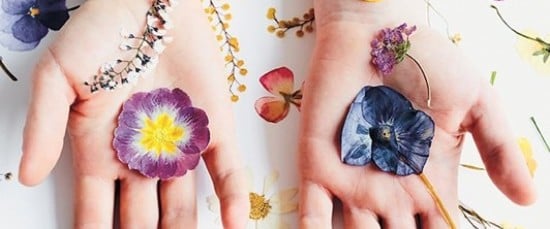Dyeing Yarn & Textiles yourself is super fun and addictive to do. Plus, you can create exactly the yarn you want yourself. That’s why we made this blog full of Tips, Tricks & Ideas around Yarn & Textile Dyeing. What do you need for it? What are the different techniques? And how do you apply it all?
One thing is for sure, once you start dyeing yarns & textiles yourself, there is no turning back and you will want to continue experimenting 😉 .
For most techniques you don’t need much and in some cases you can even get away with herbs and stuff from the pantry! So get busy with these Tips, Tricks & Ideas and discover the colorful world of dyeing Textiles & Yarns yourself.
Dye your own yarn & textiles – Tips, tricks & great ideas
Actually, you can subdivide two types of dyes. Namely natural dyeing (with plants, onion peels etc.) and dyeing with dyes you buy ready-made. Of course, there are an awful lot of tips & tricks on the internet, such as the super nice blog of Alice & Lois, where I found this beautiful picture, among others 😉 .
Whether you’re going to dye yarns or not, visit the blog for fun DIY ’s 😀
Besides the type of dye, you can of course decide what you want to do based on intended result: plain, ombre, dip dye, tie dye, ice dye are a small sample of all the possibilities you have.
Types of dyes & supplies
When you are going to dye yarn/fabric, there is one very important thing to keep in mind: use a natural fiber! Always use real wool for the best effect. If you are going to dye synthetic yarns and fabrics you need other things and the result is less reliable. You can buy nice yarns of which the composition is known via for example weareknitters.nl or etsy.com.
Do pay extra attention to the composition at etsy, if a yarn is not 100% wool, your dye adventure could fail completely 😉 .
You can also use cotton, but for that you need other dyes specifically for vegetable fibers. Therefore, in this blog I am focusing mainly on wool.
Want to make sure you have all the right supplies together? Then buy a yarn dye starter kit like this one I found on Etsy. This contains some basic supplies like wool, gloves, paint and stirrers, but also a nice booklet with techniques described in it 😉
Basic Supplies
Besides the yarn or textile, there are of course some basics that you can’t do without when you are going to dye yarn or textile:
– Old pans (if you don’t have them, buy them at the thrift store).
If you’re going to work with ready dyes, this is especially important because you can’t safely use the pans afterwards. In the case of natural dyes such as onion peels, it is of course different 😉 😉 The pans can be used in different ways.
– Gloves (very handy if you don’t want blue or yellow hands 😉 )
– Disposable cups and spoons (preferably buy disposable paper items because of the environment)
– Possibly a mouth mask, but in the examples I use here it is not really necessary.
– An old wooden spoon or sticks/ice sticks/saté picks so you can move the fabric or yarn around in the pan.
– White vinegar
– Cling film (depending on the technique)
– Squeeze bottles or small mixing bowls
– A stove
Types of Paint & Associated Techniques
Actually, the most fun is to paint with natural substances such as onion peels. This always gives a slightly different result and you don’t need any chemical stuff. It is also extra fun because you can use things that you can just buy in the supermarket for a small amount.
Below I will show you some of the possibilities.
Avocado seeds & Avocado peels
It’s very funny because the color you get may not be what you expect, namely pink!
To properly dye with avocados, you will need a nice white yarn or fabric (cotton or wool both work in this case).
You’ll also need a pan, 1 to 5 avocados and possibly a tie wrap to hold your yarn together. Below you will find the process in simple steps.
Step 1
Clean the peels and kernels, store in the freezer for so long to keep them good. You can just use the peels and kernels from the avocados you eat and save them until you have enough.
Step 2
Fill a pan with so much water that your yarn is completely submerged.
Step 3
Simmer the avocado peels and kernels until the water reaches the desired color. Do not let the water boil!
Step 4
Soak your yarn in water until it is thoroughly wet.
Step 5
Simmer the wet yarn in the colored avocado water until it reaches the desired color. Again, do not let the water boil!
Step 6
Remove the yarn from the pan and let cool completely.
Step 7
Rinse the yarn with water.
Step 8
Allow to air dry completely.
The depth of color depends on how many kernels and peels and the time you give it to simmer. I found this example and some recipes through woodsandwool.com.
The deepest and darkest pink (leftmost in the photo) was achieved with 5 kernels and 4 husks which then simmered for 3 hours and then stood overnight. It was then simmered for an hour and then left in the avocado bath for several hours without being heated.
The slightly less deep pink (second from left) was achieved with 2 kernels and 2 peels which then simmered for 3 hours and then stood overnight. The yarn was then simmered in it for 15 minutes, then the yarn was immediately removed from the pan, cooled, rinsed and dried.
The next shade (rightmost) was achieved with 2 kernels and 2 peels which then simmered for 35 minutes. Then the yarn was simmered in it for 20 minutes without the husks and kernels still in the water, then the yarn was immediately removed from the pan, cooled, rinsed and dried.
The lightest pink was achieved with 1 kernel and 1 peel, which then simmered for 30 minutes. The yarn was then simmered for an hour with the husks and kernels still in the water, after which the yarn was immediately removed from the pan, cooled, rinsed and dried.
Curcuma
Want a beautiful deep intense yellow hue? Then dye textiles with curcuma !
Curcuma is a root that is mostly used in Indian cuisine and can be bought anywhere 😉 .
Make sure you wear gloves when doing this, otherwise your hands will be yellow for a very long time 😉
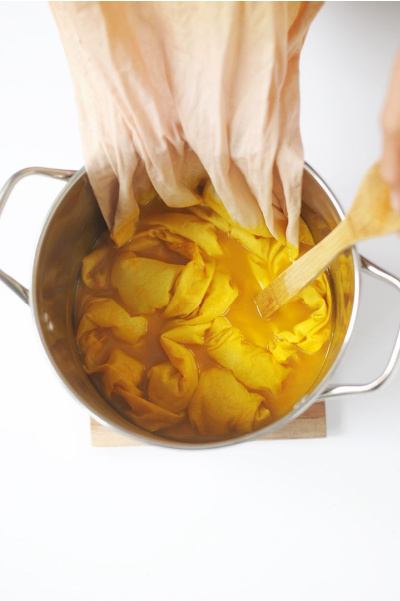
The recipe
Mix 3 tablespoons curcuma powder with 2 tablespoons vinegar into a paste.
Add water to the pan so that your yarn is completely submerged in the moment.
Stir in the curcuma. Meanwhile, soak the yarn in water for half an hour, squeeze out the excess water after the half hour.
Turn the heat to low and add the yarn. Let simmer for 15 minutes, turn off the heat and leave the yarn in the yellow water for another hour.
Remove the yarn from the pan and allow to cool completely before rinsing.
Then rinse until the water remains completely clear and then let dry completely.
Done!
Onion Peels
Dyeing with onion peels gives a yellow/brown color when using white onions and a green color when using red onions.
The recipe
Boil 33 grams of onion peels (white or red) in 2 liters of water for 1 hour.
Pre-soak the yarn again and squeeze lightly before putting it in the dye bath.
Strain the onion peels from the water.
Prickle the yarn in the onion peel water for an hour and then let stand overnight without heating.
Then rinse until the water remains completely clear and then let dry completely.
Done!
For all of these recipes, try out times and quantities to get the exact colors you want!
Food coloring
Another easy method is to dye with food coloring (you know, those little bottles you buy at the deli).
Below is a very nice short video on how to do this & you can see immediately how to use this method for a dip dye! Super nice for example to dye crocheted or knitted items!
Textile paint
In addition to these experimental paints, you can of course also use regular fabric paint. This is a little less adventurous, but you also know immediately where you stand 😉 .
How you use these paints depends on the brand and the type. Also, you can use this paint to dye not only wool, but also synthetic fibers. In addition, you can use many techniques such as dip dye or tie dye both with natural paint and with this ready-made paint. You can easily shop for textile dyes at etsy.com.
For example, the famous Dylon Textile Dye. Dylon sells both hand paints, washing machine paints and pods, so pay attention to what exactly you want to do with your paint before you buy it 😉
Tie dye, Dip dye, Ice Dye
Dyeing textiles and yarns, of course, has different possibilities and applications. For example, dip dye is super fun for crocheted or knitted items like in the video above or for macramé projects. Tie Dye is totally back and has many fun applications. Ice dye is fairly new to me, but gives such great results that I wanted to show it!
Dip Dye
To start, below is a video for the Dip Dye of a Macramé wall pendant. In the video, ready-made textile paint from the brand Rit was used. Similar textile paint can be found on Etsy.com
You can do the same with a wall hanger and homemade paint. Then hang the wall hanger partially in the natural paint and for the rest follow the instructions of the specific recipe. This is a bit trickier though because you often have to actually cook these 😉 .
Dip dye is especially fun to apply to macramé projects. Use for example with our Trendy Macramé Plant Hanger or Macramé Flagline.
Tie Dye
Tie dye everyone knows mostly from the hippie-like t-shirts, but believe me, you can achieve much more sophisticated results with it too 😉 .
Especially if you apply specific folding techniques, like the Japanese Shibori. There are many tutorials online about this, so be sure to experiment with them.
To apply this particular tie dye technique, use an indigo paint. So use this tutorial in combination with Indigo Textile Paint.
Or if you want to know more about this and experiment:
Then order this super nice Shibori Tie Dye Starter Kit with paint, binding materials and a booklet of knotting patterns.
Ice Dye
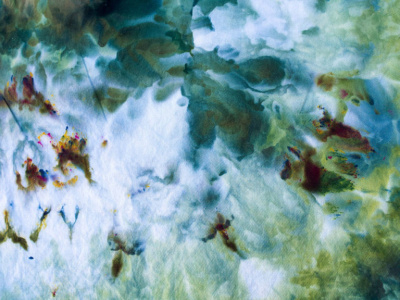
This beautiful fabric is an example of Ice Dye. A technique that gives a watercolor like result and is fairly easy to achieve.
Unfortunately I could not find any videos of this, but I did find a good written tutorial on ice dye!
A jacquard paint is used for this technique. In particular, the Procion MX Textile Paint. This paint is also suitable for multiple uses and comes in powder form.
As you can see, there are a lot of possibilities when you start dyeing your own yarn or fabric. And I haven’t even covered all the possibilities! There are just too many. So do you have a suggestion that would fit nicely in this blog? Then post it below in the comments and who knows we’ll check it out for you and include that technique in this blog too!
I am very curious about your results with these different techniques! So if you have tried something, let us know! As always, you can do that by email, below in the comments or via instagram with #beadsandbasics. Super curious!!!
Have fun creating and experimenting!
Love,
Matilde
